 |
| buzz pollinated |
(An early note – not all photos “match” the text – sorry – used writers
‘s lisence for visual advantage.)
 |
| Daddy long legs spider orchid |
We find ourselves in a wildflower retreat, Western Flora Caravan Park, no frills attached but a delightful place to stay.
 |
| Western grey kangaroo- immune to 1080 toxins |
Come with plenty of supplies unless you are rich or want a long drive back to Geraldton.
 |
| chamaecilla spirilis |
Each evening at 4:30, the host Alan Tinker takes guests and tourists for a wildflower walk. For guests it is free and for those coming in just for the walk it is $20. He really knows his stuff and he is passionate in his laconic bush way of wanting people to realize they are more than pretty flowers, but ecosystems trying to survive through the generations. Two hours passed very quickly, leaving you wanting more.
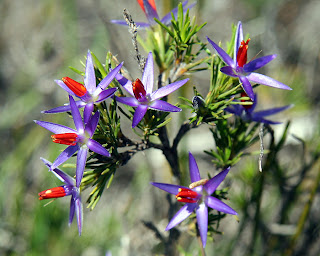 |
| calectasia cyanea |
We stopped first a metre or so from the office at a Geraldton wax, which depends on insect pollination. The problem of different coloured centers is revealed. When yellow, it is still in action, attracting insects after nectar, but when red, supply is turned off. No point feeding something else when there is no benefit to the plant. Red under ultra violet light appears black and the yellow a bright yellowish green, very bright which is what the insect sees.
 |
| painted feather flower |
Our second stop was a sandpaper wattle, an example of a plant with defence mechanisms to stop kangaroos and the like eating them.
 |
| hedgehog wattle |
We next stop at a hybrid grevillia, grevillia robin Gordon after the Queenslander responsible for its propagation. They have a flower that forces the honeyeater after the speck of nectar it is willing to provide to press through the pollen and thus succeed in pollination.
 |
| red pokers |
Scholtzia latzifloria was our next stop, another insect dependant plant, providing landing platforms for airborne insects. There are many varieties of scholtzia and hard to discriminate.
What a surprise- Not. Here are our cowslips again, caladenia flava, but we do learn there are colour variations. We had earlier noticed some with only a small red line through the top center leaf and thought that one, they were immature or two, had to be a different variety. Wrong as usual.
 |
| leek orchid |
The scarlet feather flower was the next to attract our attention. The interesting thing is that the plant in the substructure can be two hundred years old. It makes them very adaptable to fire and can regenerate quickly. It does make them difficult to propagate and like the wreath flowers, are winning the battle against scientists who thought they had the answers.
 |
| scarlet feather flower |
Milkmaids are our next port of call. Below those long slender stalks are tubers deep in the ground. Burchardia congestia was thus a native food , a sort of native potato.
 |
| lechenaultia biloba |
Seeing mats of colour on the ground over the past few weeks, we learn they are drosera, forms of sundew. Each actual plant only flowers once in its lifetime, but as it colonizes new plants then flower. They are insect pollinated and this one is commonly known as the red ink plant, because in times gone by it was used to produce an ink like substance school children used in the absence of real ink.
 |
| drosera base |
Next were cassurinas, wind pollinated with red flowers.
 |
| elythranthera brunonis |
Cotton heads abound. Look here for the native bees which burrow in the ground, lay their eggs and wait for the next flowering season for their young.
 |
| grey cottonheads |
Smokebush is also dependant on native bees. When you see that small black dot on the elk smokebush, which is actually the flower, you realize just how small the native bee is.
 |
| common smokebush |
The xmas tree looking bush has globules on the end of the plant to stop unwanted insects stealing its nectar. Often this globules are acidic and burn the insect.
 |
| Xmas tree globules |
The Chinese puzzle is another wind pollinated plant, used in the dried flower industry. You must have a permit to collect flowers, $100 per annum, but the penalty for collecting protected species is onerous and bankrupting, so there are fewer and fewer collectors.
 |
| arrowsmith orchid |
The golden gum is an example of a plant which drops petals from its flowers when it is pollinated. These are the insect landing platforms no longer needed.
 |
| mottlecah |
Some plants we see are buzz pollinated. Males present the pollen and native bees shake off the pollen from below. The males don’t have nectar. The tip of the pollinated male changes to female which supplies the nectar so the plant can be cross pollinated.
 |
| rough honey myrtle |
Sticky podathecia or golden longheads proliferate in fiedls and give a beautiful show.
 |
| golden longheads |
We come across plants with chemical defences. Grind their leaves and the pungent aroma leaves no desire to taste.
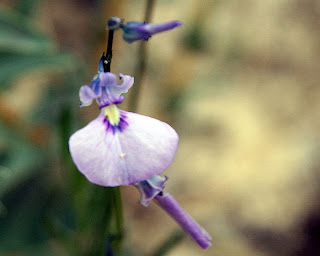 |
| purple pea |
The banksias cessalis with its white cup like flowers are an example of bird pollinated flowers.
 |
| crazy eucalypts |
We see a couple of examples of geraldton wax that have been produced. The large blooms when cut die easily and are no good for the florist industry.
 |
| Geraldton wax unsuccessful hybrid |
Another hybrid, the purple pride, has smaller flowers and is more successful as a cultivated plant, grown successfully in Canada and Israel.
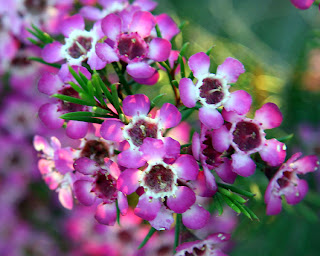 |
| hybrid Israeli Geraldton wax |
The lobechia lanciata has yellow and red centers. The red turns black, but inside the red is bright yellow, attracting the pollinator to the center where needed.
 |
| cats paws |
Granny’s bonnets we have seen before are also known as lamb’s poison, because this plant uses toxins, specifically 1080, to protect itself. This toxin is in the foliage. Interestingly the Western grey kangaroo is immune but the eastern grey is not.
 |
| boot leaved davesia |
Another example of a flower with a yellow center when active that becomes red is the starflower, a calytrix.
 |
| eneabba starflower |
Identifying hakea and grevillias are sometimes tricky and depends on where the flower grows from. I may need another lesson to become clearer on this point.
 |
| gilberts hakea |
An interesting plant that regenerates well after fire is the one-sided bottle brush.
 |
| one sided bottle brush |
The banksia hookeriana presents its flowers terminally so birds can pollenate it. This particular plant only grows in a 100x80km corridor here in WA.
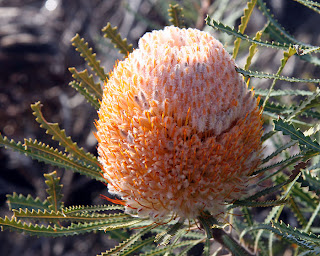 |
| hookers banksia |
After a pleasant walk and talk Allan brings us into a warm room with a special microscope that projects the image so we can see the more detailed parts of the plants that our poor eyes miss. The piece de resistance was a sprig of Geraldton wax, still active with yellow centers.
 |
| you would not believe what is in here |
It was amazing to see so many bugs and caterpillar type creatures in a single bloom. You would never sniff a flower again.
 |
| red beaks |
All this for free if you are staying in the park. Not to be missed.
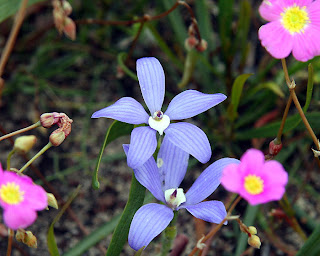 |
| scented sun orchid |

No comments:
Post a Comment